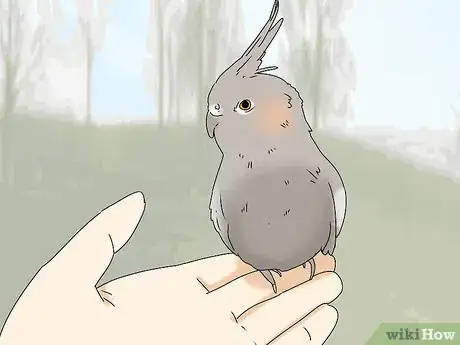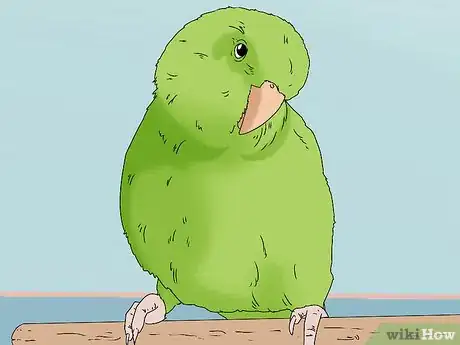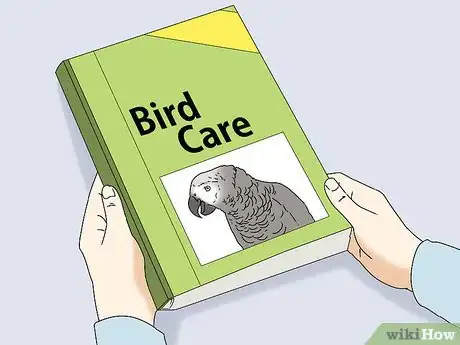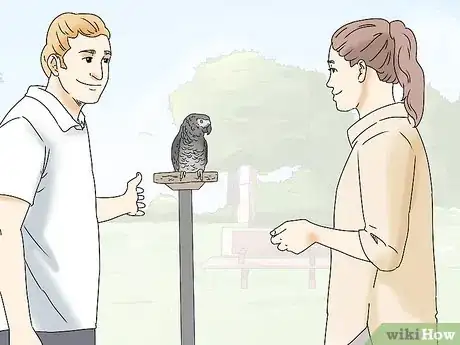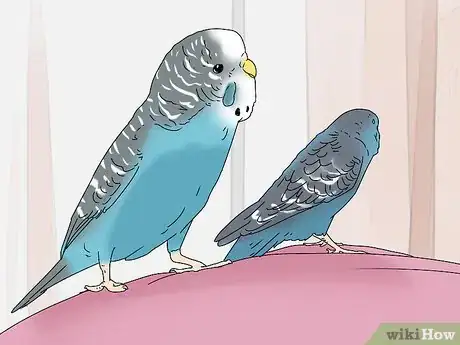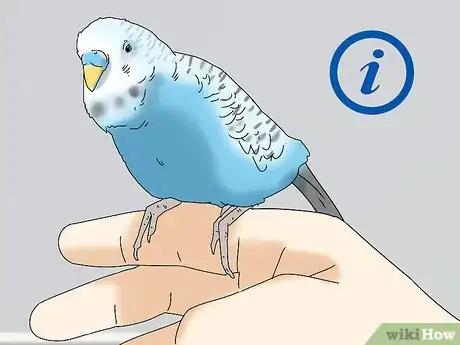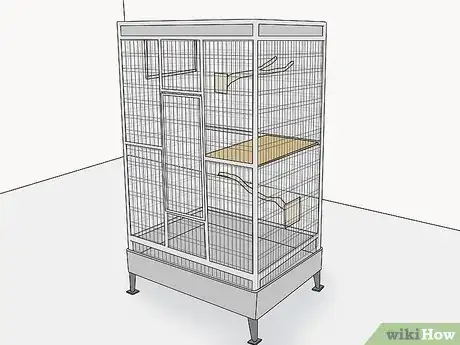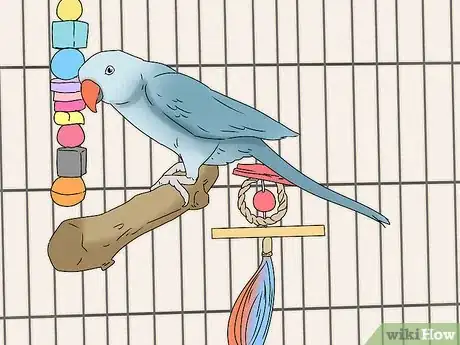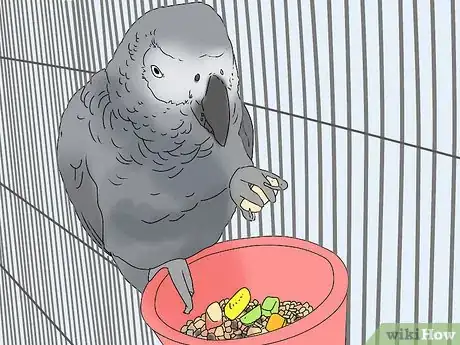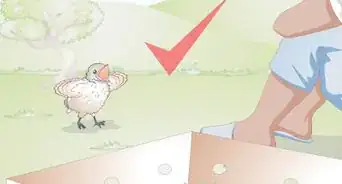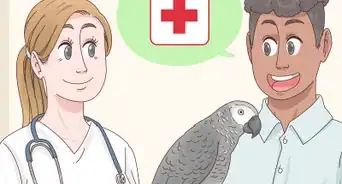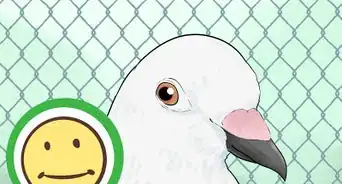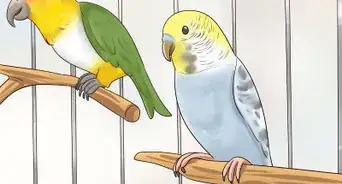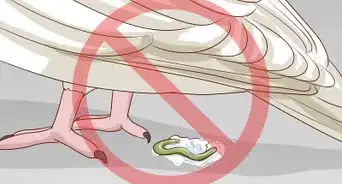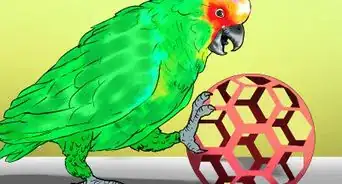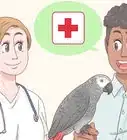This article was co-authored by Hayley Heartfield and by wikiHow staff writer, Christopher M. Osborne, PhD. Hayley Heartfield is a Bird Specialist and the Owner of About Birds, a Pet Bird Shop in Montgomery County, Texas. Hayley specializes in pet bird care, behavior, training, and breeding. Hayley studied Animal Science at Texas A&M. About Birds carries many species of birds and offers grooming and boarding services as well as bird care products.
There are 9 references cited in this article, which can be found at the bottom of the page.
wikiHow marks an article as reader-approved once it receives enough positive feedback. In this case, 100% of readers who voted found the article helpful, earning it our reader-approved status.
This article has been viewed 39,533 times.
It's easy to walk into a pet store, become mesmerized by a beautiful macaw that greets you with a "Hello," and end up driving home with a new parrot. However, macaws can live for 80 years or more, and different types of pet birds have unique dietary requirements and social needs. To prevent a situation that results in an unhappy bird and an overwhelmed owner, do your research and think carefully before buying a bird. After that, find a reputable breeder or similar source and make sure the bird is healthy and happy before buying it.
Steps
Choosing the Right Type of Bird
-
1Buy a small bird if you have limited space or children at home. Generally speaking, smaller birds—like budgies or cockatiels—are a bit easier to care for, and better suited to households with children. In most cases, the larger the bird, the more demanding it’ll be of your time, the more space it’ll require, and the less suited it will be for kids.[1]
- With instruction and supervision, even younger kids (over age 5) may be able to help care for budgies or cockatiels.
- Small birds require smaller cages, but make sure you’re still providing adequate space according to the bird breed’s needs. Talk to the breeder or your vet for guidance.
- Smaller birds tend to live shorter lifespans, often in the range of 5-10 years.
-
2Consider a mid-sized bird if you can handle the added responsibility. Mid-sized birds like parrotlets and lovebirds tend to live longer than small birds—often 10-20 years and sometimes more—and require more cage space. Birds also tend to become more needy in terms of attention as they go up in size.[2]
- Mid-sized birds can present a danger (from biting or scratching) to smaller children. If you have pre-teens or teens at home, however, parrotlets and lovebirds might work out well.
- Mid-sized (and larger) birds don’t thrive when left home alone for long stretches, so take your work schedule and social calendar into account. Smaller birds require regular attention as well, but aren’t quite so needy.
Advertisement -
3Be honest about whether you’re prepared to care for a large bird. Healthy macaws and other large bird breeds require regular attention and a lot of care. They can also live a very long time—different types of parrots can live for 30, 50, even 80+ years![3]
- Because of a large bird’s long lifespan, consider what your life might be like in 5, 10, and 20 years down the road. Are you relatively confident that you’ll be able to provide a stable, healthy home for the bird for years or decades to come?
- Larger parrots like macaws are not suited to households with children, especially younger children. Even with a trimmed beak and claws and good training, a large bird can easily injure a child.
- Don’t ignore the financial responsibility either. Even a small parakeet can cost around $500 USD per year to care for, and larger birds can cost 2 or even 3 times more. That means a macaw might be a 50-year, $75,000 USD investment![4]
-
4Learn more about the species you’re interested in. Consult bird care books and websites, and talk to fellow bird owners and reputable breeders or pet shop owners. Use this information to help further narrow down your options. For instance:[5]
- Decide if you want a really active bird that will constantly be talking and flying, or whether you want a beautiful, quieter bird just to give you company. A huge, talking African grey parrot will behave quite differently from a small, singing canary.
- Some birds need specific diets or other special care. Lories, for example, are medium-sized birds known for their striking colors. However, they have highly specialized digestive systems that require a diet of pollen, nectar, and fruit—which results in ample and messy liquid droppings.
-
5Consult your household, and maybe your neighbors, before getting a bird. A pet bird should never be an impulse buy. A bird is a major commitment, and it’s important to make sure everyone in your household is on-board with accepting the shared responsibility. In some ways, bringing home a bird is like welcoming a permanent toddler into your home![6]
- Birds are noisy pets, so if you have neighbors in close proximity, you should at least alert them beforehand. They may need to make some adjustments as well.
Getting Your Bird
-
1Work with a reputable breeder whenever possible. Ask bird-owning friends (with experience) for referrals for bird breeders in your area, and visit the breeder yourself before considering a purchase. Look around and make sure the birds are kept in clean, humane conditions, and make sure the breeder is willing to answer your questions. Ask things like:[7]
- How frequently do you breed pairs per year? (If shouldn’t be more than 3 times.)
- What kind of diet do you provide?
- What kind of veterinary care do your birds receive?
- What can you tell me about this bird’s genetic background?
-
2Evaluate a pet store and its birds before you think of buying there. Some pet stores are great places to buy birds, while others should be avoided. In addition to getting referrals from friends, you need to visit the store yourself before determining if it’s a good place to get a bird.[8]
- The store should look and smell clean, and the birds’ cages should be roomy, clean, and stocked with a variety of food and clean water. The birds should seem friendly and social, not terrified.
- Ask questions, such as: “What type of diet do you feed the birds?”; “Which breeders do you use?”; “Do you offer a 48-72-hour “health guarantee?” (This gives you time to take the bird to an avian vet to make sure it is healthy.) If they won’t or can’t give you satisfactory answers, look elsewhere.[9]
-
3Consider the added complications of taking in an abandoned bird. Unfortunately, there are large numbers of abandoned birds out there, because many people don’t recognize the commitment required for bird ownership. Abandoned birds can be well socialized, happy, and healthy, or they can have a range of health and behavioral problems.[10]
- If you’re working with a shelter or rescue operation, get as much information as possible about the bird’s previous ownership and any health or behavioral concerns. Some groups may offer training for taking in abandoned birds—if so, sign up.
- If you’re considering taking in a bird from a friend or family member who can no longer care for it (due to moving, for instance, or other reasons), spend increasing amounts of time with the bird beforehand to help ease the transition.
-
4Watch the bird you’re interested in to see if it’s lively and friendly. Birds don’t hide their personalities, so what you see is usually what you get. If a bird seems sociable and outgoing at the breeder’s or pet shop, that’s what it’ll be like at home. If it seems scared and wary of people, it probably has not been treated well and may have great difficulty becoming socialized.[11]
- There’s a difference between being more quiet and subdued (which some birds naturally are) and being terrified, though. If the bird appears to be overly anxious or fearful around people, it probably has been mistreated.
-
5Look for clear eyes, a clean bottom, trimmed talons, and smooth feathers. Healthy birds have clean, clear, glossy eyes, without discharge or gunky buildup. Likewise, there shouldn’t be fecal buildup around their backsides—this can indicate a poor diet and/or health problems.[12]
- Healthy birds take pride in self-grooming, so looking unwell is a good sign that they feel unwell.
- Even smaller birds can have dangerous talons, so these should be kept properly trimmed and maintained. Make sure the seller can tell you about the talon care procedures they use, and give you advice on how to continue this care.[13]
- Birds shouldn’t have ruffled or unkempt feathers—instead, they should be smooth and orderly. Otherwise, a bird may have a skin condition or a behavioral issue (which can lead to feather-plucking).
-
6Get as much info as possible on a bird’s diet, lifestyle, and health history. When you’ve narrowed down your search to a single bird, get as many specific answers about that bird as you can. Find out what it has been fed and how often; if it has been kept alone or with other birds; if it has had any illnesses or health issues; if it has been given time to play and socialize; and so on.[14]
- Don’t finalize your purchase until you’re completely satisfied that you’ve gotten all the answers and information you need. Always remember that buying a bird of any size is a long-term, time-intensive, and often very rewarding investment.
Buying the Necessary Supplies
-
1Purchase supplies and set up the cage before getting your bird. Before you actually purchase the bird and take it home, you should make sure you have all the preparations in place to properly care for it. This is one of the many reasons why buying a bird should never be a spur-of-the-moment decision![15] [16]
- If you think all you need is a little cage, some old newspaper, a water dish, and some birdseed, think again. Birds need lots of space, things to keep them occupied, and a varied diet.
-
2Buy a cage with multiple perches and ample room to move around. Bigger birds obviously need bigger cages. In fact, many birds will do better if you can provide a safe room—no open windows or doors, no ceiling fans, etc.—in which they can roam freely from time to time.[17]
- Canaries require a cage that is at least 18 × 18 × 24 in (46 × 46 × 61 cm), with 0.25 in (0.64 cm) bar spacing.[18]
- Cockatiels: 20 × 20 × 24 in (51 × 51 × 61 cm), 0.5 in (1.3 cm) spacing.
- Conures: 24 × 24 × 24 in (61 × 61 × 61 cm), 0.625 in (1.59 cm) spacing.
- Amazons: 34 × 24 × 36 in (86 × 61 × 91 cm), 0.75 in (1.9 cm) spacing.
- Macaws: 36 × 48 × 60 in (91 × 122 × 152 cm), 1 in (2.5 cm) spacing.
-
3Set up the cage in a good spot, and add a lining and toys. Birds like to be in the center of the action, not tucked away in an isolated room. Yet they also need a quiet place to sleep. Birds also have very sensitive respiratory systems, so you need to keep the cage far away from any smoking, heavy fragrances, chemical fumes, and so on—in fact it’s best to keep these out of your house completely.
- Line the bottom of the cage with newspapers or paper towels. This makes clean-up much easier than using wood shavings or cat litter. Plan to change the lining at least every 2 days.
- Add a sturdy bowl that can be used as a bird bath—make sure it is the right size for your bird to bathe in.
- Include bird-appropriate toys from a bird supply retailer, such as ladders, bells, and sisal rope toys.
- The cage should have perches of multiple sizes on multiple levels.
-
4Buy pellets for bird feed, and add fruits and vegetables. The easiest and best way to ensure a pet bird is getting adequate nutrition is to make high-quality bird pellets (available at pet supply retailers) the main component of its diet. For the sake of variety, supplement the pellets with bite-size pieces of corn, broccoli, carrots, yams, peas, bananas, apples, or grapes (but no citrus fruit).[19]
- Generally speaking, it’s recommended to feed a bird twice per day.
- Make sure to provide a constant supply of clean drinking water.
- Talk to your bird’s veterinarian regarding the ideal amount and mix of pellets and other foods to provide your particular bird.
Expert Q&A
-
QuestionIs a cockatoo a good pet?
 Hayley HeartfieldHayley Heartfield is a Bird Specialist and the Owner of About Birds, a Pet Bird Shop in Montgomery County, Texas. Hayley specializes in pet bird care, behavior, training, and breeding. Hayley studied Animal Science at Texas A&M. About Birds carries many species of birds and offers grooming and boarding services as well as bird care products.
Hayley HeartfieldHayley Heartfield is a Bird Specialist and the Owner of About Birds, a Pet Bird Shop in Montgomery County, Texas. Hayley specializes in pet bird care, behavior, training, and breeding. Hayley studied Animal Science at Texas A&M. About Birds carries many species of birds and offers grooming and boarding services as well as bird care products.
Bird Specialist Yes, but it's definitely a big responsibility! Cockatoos are very demanding birds that crave attention. This can lead to bad behaviors like escaping, screaming, and destruction if they don't get enough interaction. Make sure you can spend plenty of time with your Cockatoo before adopting or buying one!
Yes, but it's definitely a big responsibility! Cockatoos are very demanding birds that crave attention. This can lead to bad behaviors like escaping, screaming, and destruction if they don't get enough interaction. Make sure you can spend plenty of time with your Cockatoo before adopting or buying one! -
QuestionCan you feed baby budgies food?
 Hayley HeartfieldHayley Heartfield is a Bird Specialist and the Owner of About Birds, a Pet Bird Shop in Montgomery County, Texas. Hayley specializes in pet bird care, behavior, training, and breeding. Hayley studied Animal Science at Texas A&M. About Birds carries many species of birds and offers grooming and boarding services as well as bird care products.
Hayley HeartfieldHayley Heartfield is a Bird Specialist and the Owner of About Birds, a Pet Bird Shop in Montgomery County, Texas. Hayley specializes in pet bird care, behavior, training, and breeding. Hayley studied Animal Science at Texas A&M. About Birds carries many species of birds and offers grooming and boarding services as well as bird care products.
Bird Specialist It depends on their age! A young, un-weaned budgie will need a special formula, while older budgies can eat pellets and seeds.
It depends on their age! A young, un-weaned budgie will need a special formula, while older budgies can eat pellets and seeds. -
QuestionCan I still use air fresheners in my room if I keep my bird in there?
 Community AnswerYes, as long as you do so sparingly and make sure the room is well-ventilated.
Community AnswerYes, as long as you do so sparingly and make sure the room is well-ventilated.
Warnings
- You may need new cookware. Non-stick cookware can be deadly to parrots and other pet birds. The coating gives off an odorless fume when heated that can kill a bird within minutes.⧼thumbs_response⧽
- Scented candles, scented oils, and air fresheners pose a health hazard when you use them around your pet. Birds have extremely sensitive respiratory systems and are easily overcome by chemicals and fumes.⧼thumbs_response⧽
- Cigarette smoke is just as bad for your bird as it is for you. If you do choose to use tobacco products, use them outside away from your bird to keep it safe and healthy. And don't forget to wash your hands before handling your bird if you've recently smoked!⧼thumbs_response⧽
- Plan on waking up early. Birds wake up with the sun each morning, and they are ready to start their days bright and early. They will expect you to do the same.⧼thumbs_response⧽
- Invest in a really good vacuum. Birds are quite messy, to put it lightly. In many cases, you will need to sweep or vacuum daily to keep up with the constant flow of seed hulls and other debris that will accumulate around your pet's cage.⧼thumbs_response⧽
- You may have to get rid of some of your houseplants. Many commonly kept houseplants are toxic to birds.⧼thumbs_response⧽
- Birds are naturally attracted to shiny objects, which makes things like jewelry and sequins great targets. You will need to take these off before handling your bird, to protect yourself, your pet, and your items.⧼thumbs_response⧽
- You'll have to put up with some noise. Sure, some birds can talk, but all of them can scream, chirp, cackle, screech, tweet, and coo. Your bird will probably make a variety of these noises, and it may not always be at a time when you want to hear them.⧼thumbs_response⧽
- Don't expect your bird to be a social butterfly. While there are certain species that are more prone to becoming "one person birds" than others, it can happen to any bird, particularly if only one person cares for and interacts with it. If you are buying a bird for your family, it's imperative that everyone learns as much as they can about the bird, and participates in its care and maintenance.⧼thumbs_response⧽
- Before purchasing a bird, be sure that no one in your family is allergic, including yourself. Bird allergies are very common, and many people don't even know they have them until they get the bird!⧼thumbs_response⧽
References
- ↑ https://www.care.com/c/stories/6056/buying-a-bird-11-things-to-consider-before-g/
- ↑ https://www.care.com/c/stories/6056/buying-a-bird-11-things-to-consider-before-g/
- ↑ https://www.petfinder.com/pet-adoption/other-pet-adoption/bird-adoption-tips/
- ↑ https://www.forbes.com/2011/05/24/true-costs-owning-pet_slide.html
- ↑ https://www.petfinder.com/pet-adoption/other-pet-adoption/bird-adoption-tips/
- ↑ https://youtu.be/1sCUyufPwCI?t=20
- ↑ http://www.parrotparrot.com/owning-a-parrot/checklist-for-buying-a-bird/
- ↑ http://www.parrotparrot.com/owning-a-parrot/checklist-for-buying-a-bird/
- ↑ http://www.parrotparrot.com/owning-a-parrot/checklist-for-buying-a-bird/
- ↑ http://www.parrotparrot.com/owning-a-parrot/checklist-for-buying-a-bird/
- ↑ https://youtu.be/1sCUyufPwCI?t=95
- ↑ https://youtu.be/1sCUyufPwCI?t=95
- ↑ https://youtu.be/1sCUyufPwCI?t=95
- ↑ http://www.parrotparrot.com/owning-a-parrot/checklist-for-buying-a-bird/
- ↑ https://www.petfinder.com/pet-adoption/other-pet-adoption/bird-adoption-tips/
- ↑ Hayley Heartfield. Bird Specialist. Expert Interview. 23 June 2021.
- ↑ https://www.petfinder.com/pet-adoption/other-pet-adoption/bird-adoption-tips/
- ↑ http://www.bird-cage.com/how-to-select-a-bird-cage
- ↑ https://www.petfinder.com/pet-care/bird-care/feed-bird/
About This Article
Before you buy a bird, keep in mind that large birds like macaws and parrots can live to be 80 years old, so they're a big commitment. Even small and mid-sized birds can live for 10-20 years, so make sure you're ready for that kind of responsibility. If it's your first time owning a bird, consider getting a smaller variety, like a budgie or cockatiel, since they require less space and won't be as demanding. Whichever kind of bird you decide to get, make sure you get it from a reputable breeder or pet store. For tips on how to choose a healthy bird, scroll down!
